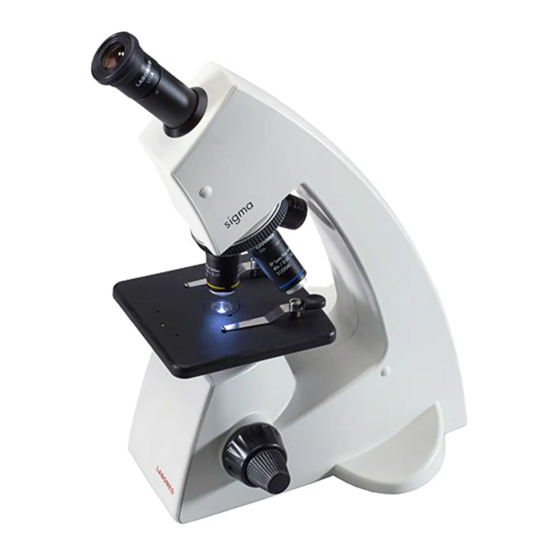
Summary of Contents for Labomed Sigma
-
Page 1: User Manual
LABOMED sigma User Manual Educational Microscopy To ensure proper use of this instrument as well as to avoid injury while operating instrument, understanding this manual completely before use is highly recommended. -
Page 3: Table Of Contents
CONTENTS INTRODUCTION SAFETY INFORMATION UNPACKING YOUR MICROSCOPE SYSTEM DIAGRAM STANDARD COMPONENTS OPTIONAL ACCESSORIES INITIAL SETUP ASSEMBLY SUMMARY OF BRIGHTFIELD OBSERVATION PROCEDURE DETAILED OBSERVATION PROCEDURE 13-14 TROUBLESHOOTING GUIDE SPECIFICATIONS... -
Page 4: Introduction
INTRODUCTION The Sigma is an educational microscope reflecting a modern design as well as the latest in optical and mechanical advancements. Designed for professionals as well as students, this microscope offers many features and functions for a diverse set of applications. -
Page 5: Safety Information
3. Install the microscope on a sturdy, level table or bench. Do not place the microscope on a flexible surface, as this could result in overheating/fire. 4. Always use the charging adapter provided by LABOMED. If the proper charging adapter is not used, product safety performance cannot be warranted. - Page 6 [Warning against risk of electric shock] [Warning against damage in non- compliance with this manual] If the warning label is stained or peeled off, contact your LABOMED distributor. Getting Ready 1. A microscope is a precision instrument with delicate glass components.
- Page 7 3. Cleaning of plastic surfaces: Sigma microscope frame is made up of special grade plastic which can be cleaned with mild soap solution. Do not use acetone for cleaning stage condenser lens.
-
Page 8: Unpacking Your Microscope
UNPACKING YOUR MICROSCOPE Power Adapter / Battery charger Mechanical stage (optional) Microscope Slides (optional) -
Page 9: System Diagram
Sigma SYSTEM DIAGRAM Integrated eyepiece with eye guard Objectives Stage clips Fine focusing knob Coarse focusing knob... -
Page 10: Standard Components
STANDARD COMPONENTS After opening the package, make sure that the correct units for the selected set are present. Integrated eyepiece Objectives Stage clips LED Adapter... -
Page 11: Optional Accessories
Sigma OPTIONAL ACCESSORIES System Diagram of Optional Accessories EP 10x EP 100x, Spring, oil EP 4x EP 40x, spring Clip-on mechanical stage LED Assembly Rechargeable Battery Installation and Operation of Optional Accessories clip-on mechanical stage The clip-on mechanical stage is mountable on the stage plate. - Page 12 Using clip-on mechanical stage (figure 5): Open the bow-shaped lever (4) by pulling lever handle (3) and place specimen slide on the stage. After positioning your specimen slide, return the bow-shaped lever (4) gently by slowly releasing lever handle (3). Use X-axis movement control knob (2) and Y-axis movement control knob (1) for horizontal and vertical movements respectively.
-
Page 13: Initial Setup
Sigma INITIAL SET UP The microscope must be charged for at least eight hours before initial use. To charge microscope, plug-in the adapter (1) in the input socket provided at rear of the microscope. See figure 6. Fig. 6 Objectives are factory set. Objectives are par-centered and par- focalised during assembly phase. -
Page 14: Assembly
Applicable LED replacement: LED P/N 9135000-950 Always use the designated parts. Using an LED other than those specified by LABOMED may lead to a fire hazard or improper light level. If contamination occurs, wipe bulb surface with a cloth slightly moistened with alcohol. -
Page 15: Summary Of Brightfield Observation Procedure
Sigma SUMMARY OF BRIGHTFIELD OBSERVATION PROCEDURE Rotate the knob towards “I” (ON) Place the specimen on the stage Engage the 10X objective in the light path ON/OFF Knob Bring the specimen in focus Engage the objective to be used in the light... -
Page 16: Detailed Observation Procedure
DETAILED OBSERVATION PROCEDURE Turning the Lamp ON 1. Rotate the On/OFF control knob to I (ON) ” ” as shown in figure 10. 2. Rotating the light intensity adjustment knob (fig. 10) in the direction of the arrow increases brightness and rotating it in the opposite direction decreases brightness. - Page 17 Sigma Adjusting the Focus Focusing Procedure (Fig. 13) 1. Rotate the coarse adjustment knob (1) clockwise so that the objective (3) is as close as possible to the specimen (We recommend starting with 10X). 2. While observing the specimen through the eyepiece, slowly rotate the coarse adjustment knob (1) counterclockwise to lower the stage.
-
Page 18: Troubleshooting Guide
Under certain conditions, performance of the unit may be adversely affected by factors other than defects. If problems occur, please review the following list and take remedial action as needed. If you cannot solve the problem after checking the entire list, please contact Labomed for assistance. Trouble... -
Page 19: 2 Specifications
Sigma SPECIFICATIONS 1. Illumination Built-in illumination system LED type 2. Focusing mechanism Stage height adjustment mechanism Fine adjustment stroke: 0.2mm per turn Total stroke: 8mm Co-axial coarse and fine focusing with gear movements 3. Revolving nosepiece Quadruple nosepiece (reverse angle) 4. - Page 20 CA 94538 sales@laboamerica.com LABOMED and Sigma are registered trademarks of Labo America, Inc. With a policy of continuous development, Labo America, Inc. reserves the right to change design and specifications without prior notice. © 2009 Labo America, Inc. | 2124000-990A 12-2009...














Need help?
Do you have a question about the Sigma and is the answer not in the manual?
Questions and answers